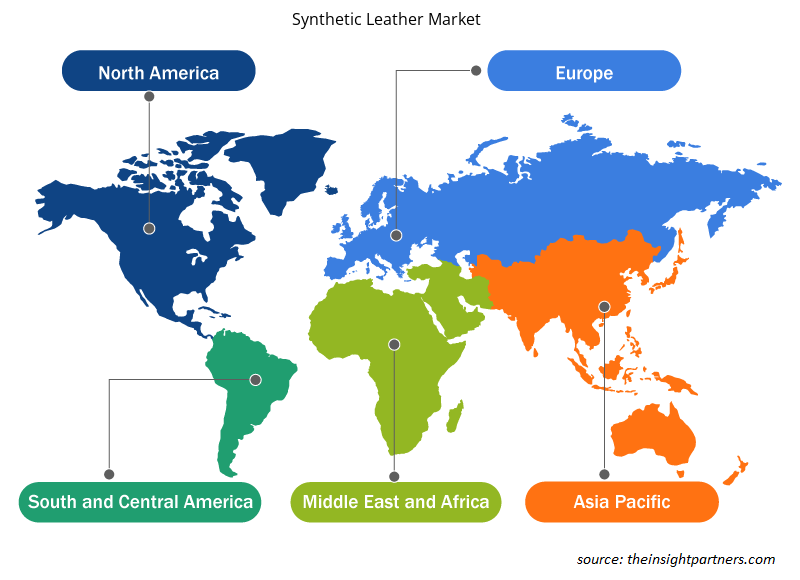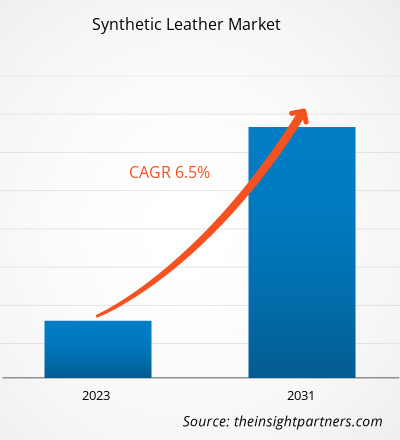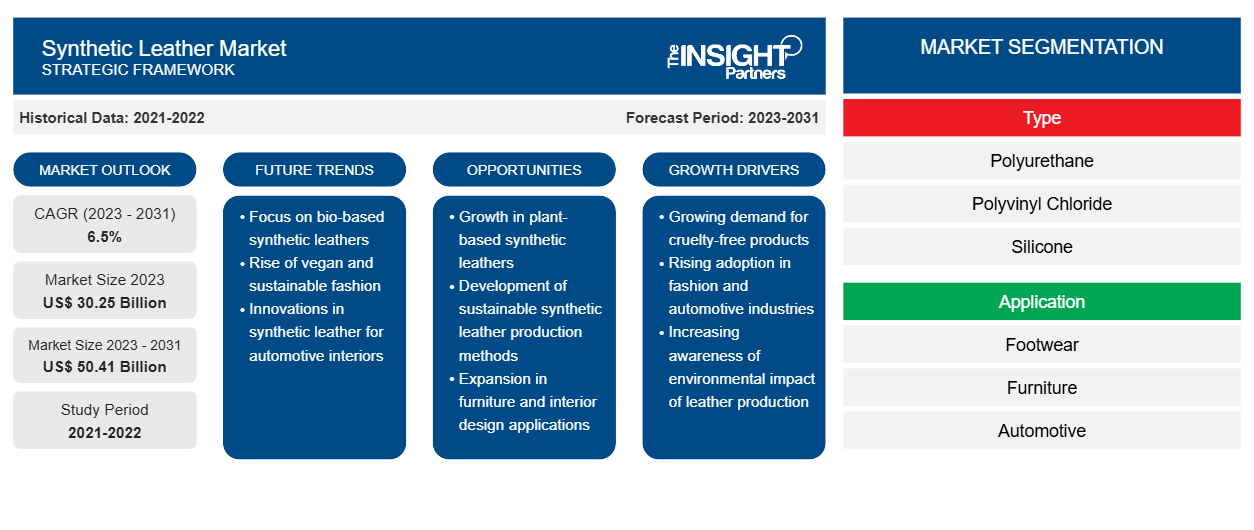Si prevede che la dimensione del mercato della pelle sintetica raggiungerà i 50,41 miliardi di dollari entro il 2031, rispetto ai 30,25 miliardi di dollari del 2023. Si prevede che il mercato registrerà un CAGR del 6,5% nel 2023-2031. È probabile che la crescente attenzione allo sviluppo della pelle di origine biologica rimanga una tendenza chiave del mercato della pelle sintetica.
Analisi del mercato della pelle sintetica
La pelle sintetica ha guadagnato popolarità negli ultimi anni. È utilizzata in vari settori, tra cui calzature, abbigliamento, arredamento e automotive. L'uso più comune della pelle sintetica è nell'abbigliamento, nei bagagli e nelle custodie. La pelle sintetica è sempre più utilizzata in giacche, cappotti, borse, borsette, cinture, ecc. La pelle sintetica è adatta per applicazioni nelle calzature grazie al suo basso costo e alla resistenza all'abrasione.
Panoramica del mercato della pelle sintetica
La pelle sintetica viene preparata tramite estrusione di materie prime come cloruro di polivinile, poliuretano, pigmenti colorati, materiali di supporto e altri. Si prevede che la crescente domanda da parte di settori quali arredamento, calzature e automotive stimoli la domanda di pelle sintetica. Inoltre, si prevede che i crescenti investimenti da parte dei principali attori stimoleranno la crescita del mercato.
Personalizza questo report in base alle tue esigenze
Riceverai la personalizzazione gratuita di qualsiasi report, comprese parti di questo report, o analisi a livello nazionale, pacchetto dati Excel, oltre a usufruire di grandi offerte e sconti per start-up e università
-
Scopri le principali tendenze di mercato in questo rapporto.Questo campione GRATUITO includerà analisi di dati che spaziano dalle tendenze di mercato alle stime e alle previsioni.
Driver e opportunità del mercato della pelle sintetica
Vantaggi della pelle sintetica
La pelle sintetica offre diversi vantaggi. Riflette un aspetto visivo con una qualità della pelle realistica quando modificata e migliorata. È un materiale versatile disponibile in una varietà di colori, finiture e motivi. Il costo della pelle sintetica è inferiore rispetto alla vera pelle, il che la rende un'opzione molto più conveniente. Inoltre, la pelle sintetica è un materiale impermeabile e può resistere alla penetrazione dell'acqua poiché è composta da uno strato di base in plastica con un rivestimento in plastica. Di conseguenza, la pelle sintetica è la scelta perfetta per applicazioni con esposizione continua a umidità e umidità. Pertanto, i vantaggi associati all'uso della pelle sintetica stanno guidando il mercato.
Crescente domanda da parte dell'industria calzaturiera
L'industria calzaturiera è uno dei segmenti significativi dell'industria della pelle sintetica. L'elevata domanda di scarpe sta offrendo opportunità all'industria calzaturiera di svilupparsi e crescere. Il materiale in pelle sintetica è adatto alle scarpe grazie al suo basso costo e alla resistenza all'abrasione. Inoltre, le scarpe in pelle sintetica offrono grandi qualità impermeabili. La pelle sintetica può essere mescolata con alcune sostanze chimiche per aggiungere caratteristiche impermeabili. C'è un'elevata domanda di pelle sintetica da parte dell'industria calzaturiera. Inoltre, molti marchi di calzature si stanno concentrando sullo sviluppo di scarpe in pelle vegetale e scarpe in pelle vegana. Ciò sta ulteriormente contribuendo all'elevata domanda di pelle sintetica. Pertanto, la crescente domanda da parte dell'industria calzaturiera crea opportunità nel mercato della pelle sintetica.
Analisi della segmentazione del rapporto di mercato sulla pelle sintetica
I segmenti chiave che hanno contribuito alla derivazione dell'analisi del mercato della pelle sintetica sono l'olio base, il tipo di prodotto e il settore di utilizzo finale.
- In base al tipo, il mercato della pelle sintetica è suddiviso in poliuretano, cloruro di polivinile, silicone e altri. Il segmento del poliuretano ha detenuto una quota di mercato maggiore nel 2023.
- Per applicazione, il mercato è suddiviso in calzature, arredamento, automotive, abbigliamento, articoli di cancelleria e altri. Il segmento delle calzature ha detenuto la quota maggiore del mercato nel 2023.
Analisi della quota di mercato della pelle sintetica per area geografica
L'ambito geografico del rapporto sul mercato della pelle sintetica è suddiviso principalmente in cinque regioni: Nord America, Europa, Asia Pacifico, Europa, Medio Oriente e Africa e Sud America/Sud e Centro America.
L'Asia Pacifica ha dominato il mercato della pelle sintetica. Il mercato delle calzature dell'Asia Pacifica è guidato dalla rapida urbanizzazione, dalla crescita della popolazione e dall'industrializzazione in paesi come Cina, Indonesia e India. Inoltre, la penetrazione di piattaforme di e-commerce come Amazon e Alibaba ha facilitato l'acquisto conveniente di calzature da parte dei consumatori. Di conseguenza, la crescente domanda da parte dell'industria calzaturiera, della moda e dell'industria dell'imbottitura include un'ampia varietà di articoli come scarpe e giacche, valigie e portafogli e interni di auto, in particolare sedili, custodie per dispositivi elettronici e divani. Si prevede che l'Asia Pacifica sarà la regione in più rapida crescita nel prossimo periodo.
Approfondimenti regionali sul mercato della pelle sintetica
Le tendenze regionali e i fattori che influenzano il mercato della pelle sintetica durante il periodo di previsione sono stati ampiamente spiegati dagli analisti di Insight Partners. Questa sezione discute anche i segmenti e la geografia del mercato della pelle sintetica in Nord America, Europa, Asia Pacifico, Medio Oriente e Africa e America meridionale e centrale.

- Ottieni i dati specifici regionali per il mercato della pelle sintetica
Ambito del rapporto sul mercato della pelle sintetica
| Attributo del report | Dettagli |
|---|---|
| Dimensioni del mercato nel 2023 | 30,25 miliardi di dollari USA |
| Dimensioni del mercato entro il 2031 | 50,41 miliardi di dollari USA |
| CAGR globale (2023-2031) | 6,5% |
| Dati storici | 2021-2022 |
| Periodo di previsione | 2023-2031 |
| Segmenti coperti |
Per tipo
|
| Regioni e Paesi coperti |
America del Nord
|
| Leader di mercato e profili aziendali chiave |
|
Densità degli attori del mercato della pelle sintetica: comprendere il suo impatto sulle dinamiche aziendali
Il mercato del mercato della pelle sintetica sta crescendo rapidamente, spinto dalla crescente domanda degli utenti finali dovuta a fattori quali l'evoluzione delle preferenze dei consumatori, i progressi tecnologici e una maggiore consapevolezza dei vantaggi del prodotto. Con l'aumento della domanda, le aziende stanno ampliando le loro offerte, innovando per soddisfare le esigenze dei consumatori e capitalizzando sulle tendenze emergenti, il che alimenta ulteriormente la crescita del mercato.
La densità degli operatori di mercato si riferisce alla distribuzione di aziende o società che operano in un particolare mercato o settore. Indica quanti concorrenti (operatori di mercato) sono presenti in un dato spazio di mercato in relazione alle sue dimensioni o al valore di mercato totale.
Le principali aziende che operano nel mercato della pelle sintetica sono:
- Società per azioni Kuraray Co., Ltd.
- SAN FANG CHEMICAL INDUSTRY CO., LTD.
- TEIJIN LIMITATA
- CORPORAZIONE DI PLASTICA NAN YA
- Società anonima
- Alfatex Italia
Disclaimer : le aziende elencate sopra non sono classificate secondo un ordine particolare.

- Ottieni una panoramica dei principali attori del mercato della pelle sintetica
Notizie e sviluppi recenti sul mercato della pelle sintetica
Il mercato della pelle sintetica viene valutato raccogliendo dati qualitativi e quantitativi dopo la ricerca primaria e secondaria, che include importanti pubblicazioni aziendali, dati associativi e database. Di seguito è riportato un elenco degli sviluppi nel mercato:
- General Silicones (GS), produttore esperto di prodotti in silicone con 50 anni di esperienza, annuncia la disponibilità della sua nuova serie di prodotti in pelle vegana in silicone Compo-SiL® SL. La serie SL è adatta ai produttori di prodotti di consumo come borse e zaini, scarpe, portafogli, cinture, rilegature e copertine che cercano forniture in pelle vegana con fodera in tessuto applicata in fabbrica. (Fonte: General Silicones Co., Ltd., Company News, 2023)
Copertura e risultati del rapporto sul mercato della pelle sintetica
Il rapporto "Dimensioni e previsioni del mercato della pelle sintetica (2021-2031)" fornisce un'analisi dettagliata del mercato che copre le seguenti aree:
- Dimensioni del mercato e previsioni a livello globale, regionale e nazionale per tutti i segmenti di mercato chiave coperti dall'ambito
- Dinamiche di mercato come fattori trainanti, vincoli e opportunità chiave
- Principali tendenze future
- Analisi dettagliata delle cinque forze di Porter e SWOT
- Analisi di mercato globale e regionale che copre le principali tendenze di mercato, i principali attori, le normative e gli sviluppi recenti del mercato
- Analisi del panorama industriale e della concorrenza che copre la concentrazione del mercato, l'analisi della mappa di calore, i principali attori e gli sviluppi recenti
- Profili aziendali dettagliati
- Analisi storica (2 anni), anno base, previsione (7 anni) con CAGR
- Analisi PEST e SWOT
- Valore/volume delle dimensioni del mercato - Globale, Regionale, Nazionale
- Industria e panorama competitivo
- Set di dati Excel
Report recenti
Testimonianze
Motivo dell'acquisto
- Processo decisionale informato
- Comprensione delle dinamiche di mercato
- Analisi competitiva
- Analisi dei clienti
- Previsioni di mercato
- Mitigazione del rischio
- Pianificazione strategica
- Giustificazione degli investimenti
- Identificazione dei mercati emergenti
- Miglioramento delle strategie di marketing
- Aumento dell'efficienza operativa
- Allineamento alle tendenze normative























 Ottieni un campione gratuito per - Mercato della pelle sintetica
Ottieni un campione gratuito per - Mercato della pelle sintetica